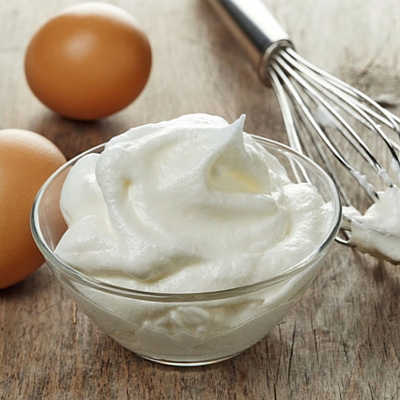
Egg White
What is Egg White?
Egg whites make up around 60 percent of an egg’s total weight. The albumen, or “white,” consist of a chalaziferous layer which surrounds the yolk, and an inner thin layer, outer thick, and outer thin layer.1 Water is a key component as well.
Total Solids in Egg Whites
Solids make up to 12 percent in the albumen. However, it can be slightly less depending on moisture loss and the size of eggs used. Smaller eggs tend to have higher solid levels, compared to larger ones. Therefore, to replace 100g of fresh egg whites, use 12g egg white or meringue powder and 88g water. Typically, pH levels run from 7.6 to 9.3.2
Real Egg White vs. Egg White Powder
The most widely used commercially produced egg white comes in two forms: Liquid egg white or egg white powder. Both begin production the same way. Whole eggs are broken and separated by automated equipment. Liquid egg whites are then filtered, pasteurized, and other ingredients are added to improve shelf life. Some of these liquid eggs are then dehydrated into a white powder.3
Both dried and liquid versions react very similar in baked goods. Dried egg white powder is beneficial for it’s convenient storage, long shelf life, and it is easier to cook without breaking eggs and separating the yolk. However, the versions liquid are easier to use with in fresh products.
Commercial Production
In commercial production, egg whites are treated before being frozen as liquid or dried into powder. Glucose is removed, and then they are clarified, filtered and spray dried before undergoing a pasteurization process at a temperature of at least 130 degrees F or 54 degrees C for 7 to 10 days. To improve gel strength and whipping ability, manufacturers often exceed required pasteurization regulations.4
Powdered egg whites are simply made by dehydrating egg whites and then grinding them into powder. Another method used involves spraying droplets of liquid egg whites into a stream of hot air, instantly creating the dried product without the grinding process.
Sodium lauryl sulfate is sometimes used as a whipping additive, while carbohydrates are added to increase resistance to heat damage.4
Application
Egg white powder can either be rehydrated or left as a powder. For rehydration, mix 2 tsp of egg white powder and two tbsp. of warm water for 1 oz. of egg white. It will take some time to mix, but mix gently to avoid foam. Powdered egg white is often used as a stabilizer for foams or to give baked goods added texture.
Keep dried and powdered egg products in a cool dark place, until reconstituted. Then, use right away or keep refrigerated for four days. Liquid egg whites should be frozen, and refrigerated for a few days after thawed.
FDA Regulations
The FDA groups dried, frozen, and liquid egg whites all under “egg whites” on labels. All egg products must be labeled under the common name of the egg product, such as egg whites, and list other added ingredients. The Food Safety and Inspection Service (FSIS) is responsible for inspecting egg products, with or without added ingredients.
References
- Mine, Yoshinori, and Icy D’silva. “Bioactive Components in Egg White.” Egg Bioscience and Biotechnology (2008): 141-84. Web.
- Clark, Stephanie, Stephanie Jung, and Buddhi Lamsal. Food Processing: Principles and Applications. N.p.: n.p., n.d. Print.
- United States Department of Agriculture
- The Incredible Edible Egg Eggcyclopedia. Park Ridge, IL: American Egg Board, 1999. Print.

